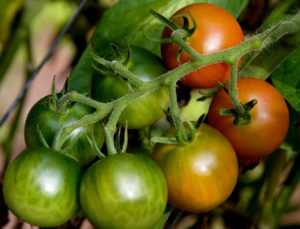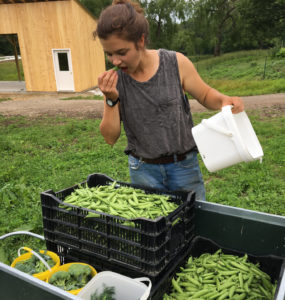Earlier this semester, Courtney and I were discussing what the kitchen has made in the past. When she mentioned kimchi/ spicy fermented cabbage (김치) my ears perked up. I was excited to hear Chewonki had fermented one of my favorite foods before. We talked about the process the cooks used, and I wanted to do it myself. I am familiar with the art of kimchi making since my grandparents have made this staple for decades since leaving South Korea. My mother too as a result of her obsession with cooking shows has an extensive knowledge on Korean food and has instructed me before in the process before, so I was not underprepared in this kitchen.
On a February work program, we cut radishes, daikon, carrots and, of course, cabbage! After getting all the excess water out, and adding in the pepper flakes/gochugaru (고추가루), salt, and garlic, we put it in a big bucket to ferment in the root cellar. I did some infrequent checking to see if it was right between the fine line of rotting and pickling. The sweet spot if you will. By May, it was ready to be served.
The kitchen and I planned a “simple” Korean lunch. Korean meals consist of a lot of rice/bap (밥), side dishes/panchan (반찬), and usually some meat. I gave the recipes and helped make spicy tofu/dubujorim (두부조림), spicy radish slaw/musaengchae (므생채), mung beans/kongnamul (콩나물), kimchi, sweet potatoes/gamjajorim (감자조림), kimchi fried rice/kimchibokkeumbap (김치볶음밥), and beef wraps/samchan (삼찬).
A traditional Korean meal takes about a whole day. It can be a lot of preparation. Today, side dishes can be bought premade in stores, but at Chewonki, this is not the case. Chopping daikon, making a mixture of sauces, and cutting tofu was all manually processed, and I must say, tasted very homemade as a result. The food reminded me of something my mother or grandmother would make. It didn’t look like it was from a restaurant, but this is a good thing. Korean food was never meant to be beautiful; its focus was always substance and quality.
Korean food was never cooked with measurements. Even in published cookbooks, ingredients are measured in odd amounts since there is disagreement on recipes. Some people say to add a lot of sugar to the beef/bulgogi (불고기), while some people say it needs Sprite (yes, the soda). I was a little worried how the meal would turn out. However, the final product smelled correct. This was a relief. The smell being correct meant that everything was in gastronomic order, and tasting it, my olfactory foresight was reassured.
– Ben Chung, Semester 52













